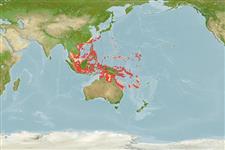分類 / Names
俗名 | 同種異名 | Catalog of Fishes(屬, 種) | ITIS | CoL | WoRMS | Cloffa
Teleostei >
Eupercaria/misc (Various families in series Eupercaria)
鱸形目 (Various families in series Eupercaria) >
Caesionidae (Fusiliers)
烏尾鮗科 (Fusiliers) > Caesioninae
Etymology: Pterocaesio: Greek, pteron = wing, fin + Latin, caesius = blue grey (Ref. 45335).
More on author: Bleeker.
Environment: milieu / climate zone / depth range / distribution range
生態學
海洋 礁區魚類; 非遷移的; 深度上下限 0 - 50 m (Ref. 402). 熱帶; 30°N - 24°S, 97°E - 171°E (Ref. 402)
Indo-Wes Pacific.
Report from Réunion (Ref. 4517) is probably a misidentification of Pterocaesio marri.
西太平洋: 印尼與澳洲到新加勒多尼亞西部, 北至日本南部。 最近記錄自諾福克島 (參考文獻 8881) 與東加。 (參考文獻 53797) 可能是一個 Pterocaesio marri 的錯誤鑑定的來自留尼旺島 (參考文獻 4517) 的報告.
Length at first maturity / 大小 / 重量 / 年齡
Maturity: Lm 21.3 range ? - ? cm
Max length : 30.0 cm TL 雄魚/尚未辨別雌雄; (Ref. 402)
背棘 (總數) : 10; 背的軟條 (總數) : 14 - 16; 臀棘: 3; 臀鰭軟條: 11 - 12. Body blue to greenish dorsally, white ventrally. With two thin yellow to orange lines; lower line mostly just below lateral line. Black tips on caudal fin (Ref. 48636). 4-5 scales on cheek; 24-31 predorsal scales; scaled dorsal and anal fins. Upper peduncular scale rows usually 12 or 13 (11-14); lower peduncular scale rows usually 16 or 17 (16-18). A broad process on ventrolateral surface of basioccipital for attachment of Baudelot's ligament, extending ventrally beyond a horizontal with condyle's rim, adjacent to condyle. Post maxillary with 2 processes; posterior end of maxilla tapered (Ref. 1723). Head length 3.0-3.5 in SL; body depth 3.5-4.1 in SL (Ref. 90102).
身體藍色到呈綠色的背面, 腹側白色的。 有兩個細的黃色到橘色的線; 低的線大部份在側線正下方。 在尾鰭上的黑色的頂端.(參考文獻 48636) 在頰上的 4-5 鱗片; 24-31個前背的鱗片; 覆有鱗片的背鰭與臀鰭。 上柄的鱗片列通常 12 或 13;(11-14) 下柄的鱗片列通常 16 或 17.(16-18) 在 Baudelot 的結帶的附著的基枕骨的腹側表面方面的一個寬的突起, 腹地延伸超過一與骨阜的邊緣,鄰近骨阜保持水平。 上頜骨有 2個突起; 顎骨的後端成錐形。
Found in coastal areas, primarily around coral reefs (Ref. 402), turning bright red (Ref. 48636). Feed on zooplankton in midwater aggregations (Ref. 402). Oviparous, with numerous, small pelagic eggs (Ref. 402).
發現於沿岸區域., 主要地珊瑚礁 (參考文獻 402) 的周圍, 變鮮紅色.(參考文獻 48636) 在中層水域群集中捕食浮游動物。 (參考文獻 402) 卵生的, 有很多的, 小型大洋性魚類卵.(參考文獻 402)
Life cycle and mating behavior
Maturities | 繁殖 | Spawnings | Egg(s) | Fecundities | 仔魚
Mating behavior observed from an aquarium include six distinguishable patterns: 1) up and down swimming; 2) courtship; 3) rushing; 4) pair spawning; 5) sperm release by sneakers; and 6) post spawning (Ref. 37529).
At nearly sunset, the usual quiet pack of fish give way to spawners swimming at the surface. A male selects a female and initiates pecking and pushing of the female's abdomen with his snout. At the rushing stage, the male pushed the female forward, and the couple began to swim in a semicircle in short bursts while other 10-15 sneakers within the school joined in. The initial couple then released eggs and sperm at the surface with their abdomens facing one another. Some of the leading sneakers may also release sperm at the same spot where the initial couple spawned. After spawning, the pair with the sneakers return to the school (Ref. 37529).西太平洋: 印尼與澳洲到新加勒多尼亞西部, 北至日本南部。 最近記錄自諾福克島 (參考文獻 8881) 與東加。 (參考文獻 53797) 可能是一個 Pterocaesio marri 的錯誤鑑定的來自留尼旺島 (參考文獻 4517) 的報告.
Carpenter, K.E., 1987. Revision of the Indo-Pacific fish family Caesionidae (Lutjanoidea), with descriptions of five new species. Indo-Pac. Fish. (15):56 p. (Ref. 1723)
人類使用
漁業: 商業性
工具
特別的報告
下載 XML
網路資源
Estimates based on models
Preferred temperature (Ref.
123201): 24.7 - 29, mean 28 °C (based on 702 cells).
Phylogenetic diversity index (Ref.
82804): PD
50 = 0.5002 [Uniqueness, from 0.5 = low to 2.0 = high].
Bayesian length-weight: a=0.01148 (0.00627 - 0.02102), b=3.16 (3.00 - 3.32), in cm total length, based on LWR estimates for this species & Genus-body shape (Ref.
93245).
營養階層 (Ref.
69278): 3.4 ±0.48 se; based on food items.
回復力 (Ref.
120179): 中等的, 族群倍增時間最少 1.4 - 4.4年 (tm=2-3).
Fishing Vulnerability (Ref.
59153): Low vulnerability (20 of 100).
Nutrients (Ref.
124155): Calcium = 55.6 [35.8, 81.2] mg/100g; Iron = 0.675 [0.441, 0.997] mg/100g; Protein = 18.8 [17.8, 19.7] %; Omega3 = 0.14 [0.10, 0.20] g/100g; Selenium = 28.6 [17.5, 48.8] μg/100g; VitaminA = 147 [57, 378] μg/100g; Zinc = 1.25 [0.91, 1.66] mg/100g (wet weight);
